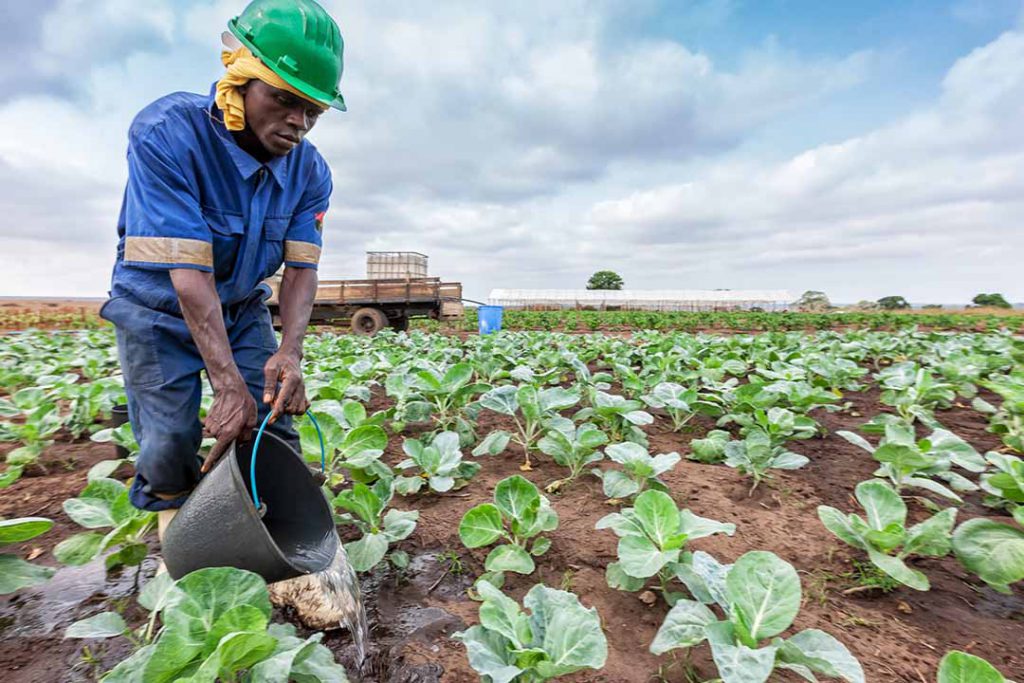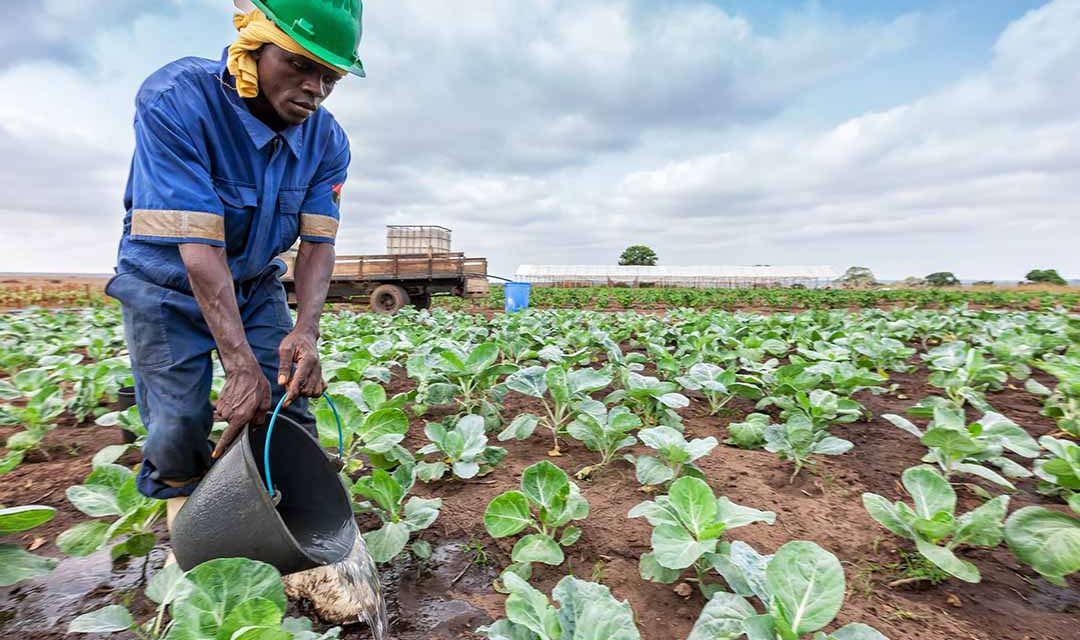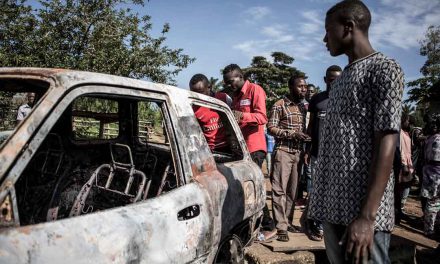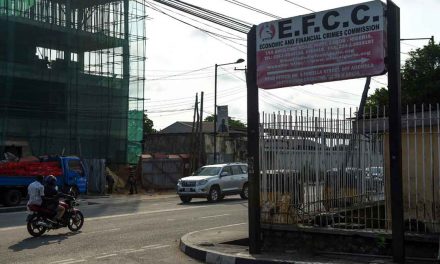SDG 2: zero hunger
Policies are at the core of eradicating hunger and many African countries are now aligning the SDGs with national development plans

Farmer tending cabbages in Angola. Photo: iStock.com
By Esther Ngumbi
Despite the progress made over the past few decades, a staggering 257 million Africans are hungry and food insecure. The majority of the hungry live in rural areas. Their livelihoods and daily food consumption depend on agriculture, which is, in turn, dependent on natural resources – including groundwater and the soil. A changing climate, worsening environmental conditions, conflict and economic turbulence are further exacerbating the situation.To attain Sustainable Development Goal 2 (zero hunger) by 2030, African countries will need to take full ownership of the SDG approach. This implies a change in mindset, as argued in a 2014 report by the Ugandan Academy of Sciences reviewing the African experience of involvement in efforts to attain the Millennium Development Goals (MDGs), which preceded the SDGs and ran from 2000 to 2015. “Historically, Africans have rarely led the development process,” the report says. It points to policies of import substitution, industrialisation policies in the 1960s and structured adjustment programmes in the 1970s and 1980s. Similarly, the MDGs were not aligned to “an agriculture-driven structural transformation that African leaders agreed to in the Maputo Declaration of 2003”, the report argued.
It was for this reason that African countries sought, and were successful in achieving, more substantial influence over the formulation of the SDGs. The next step was to localise each SDG. This is already happening in several Africa countries. South Africa, for example, released a Sustainable Development Goals: Indicator Baseline report in 2017, mapping plans to align efforts at attaining the SDGs with the country’s National Development Plan. Similarly, Kenya’s 2017 Voluntary National Review mapped out plans regarding the SDGs in relation to the country’s Vision 2030, and resulted in an SDGs Road Map report, a document that is guiding the country in its efforts to meet SDG goals. Other countries that are compiling similar national reviews are Ethiopia, Tanzania, Nigeria, Niger, Sudan and Somalia. As regards SDG 2, many of the top performing 11 African countries – Morocco, Benin, Ghana, Senegal, Kenya, Rwanda, Cameroon, Gabon, Namibia, South Africa and Zambia – have action plans outlining how they aim to achieve SDG 2 by 2030, according to the 2018 Africa SDG Index report.
Emerging from these early national reviews on the SDGs is a growing recognition that attaining SDG 2, in particular, will take on different trajectories in different African countries, because the causes of food and nutrition insecurity vary. The United Nations World Food Programme is working with several African countries to carry out Zero Hunger Strategic Reviews aimed at highlighting the challenges each country faces in efforts to eradicate hunger, food insecurity and malnutrition. The strategy has included appointing respected high-level national figures as lead conveners of the national reports. Some 19 African countries have so far participated in these exercises, including Burkina Faso, Cameroon, the Central African Republic (CAR), Chad, Djibouti, Liberia, Mali, Mozambique, Namibia, Rwanda, Tanzania, São Tomé and Príncipe, Ghana, Senegal, Gambia and Togo. Ghana has performed relatively well in measures aimed at achieving SDG 2. It was the first African country to meet its MDG in this respect, and garnered global praise for its efforts to reduce poverty, hunger and malnutrition between 1990 and 2014.
Despite this, hunger and food insecurity persist, especially in the northern, upper east and upper west regions, as well as in many rural and peri-urban communities across the nation. Nearly 20% of children under five in Ghana are malnourished, according to the country’s 2017 Zero Hunger Review. Major causes include persistent low agricultural productivity, a poor resource base, contamination of harvested food by aflatoxins, and climate and weather-related factors such as drought. The proposed solutions include supplying and subsidising agricultural inputs, investing in water and irrigation technologies, expanding the country’s agricultural extension services, improving research capacity, and investing in modern food and grain storage equipment. In Uganda, weather-related factors such as drought, inadequate policies, regional geopolitics, structural causes, the low use of productivity enhancing technologies, gender inequalities, and a lack of early warning systems and disaster preparedness plans are cited in that country’s 2017 Zero Hunger Review as major factors affecting its ability to attain SDG 2.
Some of the solutions proposed include investment in early warning systems and addressing the structural causes of food and nutrition insecurity by undertaking land reforms, strengthening and promoting equitable land ownership rights and instituting functioning and regulated markets. In Rwanda, 17% of the population is moderately food insecure according to its 2018 Strategic Review of Food and Nutrition Security. The chief reasons include low agricultural productivity gains for smallholder farmers, fluctuating food prices, inadequate post-harvest storing equipment and a dysfunctional national food reserve. The proposed solutions are multi-sectoral, involving cooperation with a range of stakeholders and partners, including the UN Children’s Fund (UNICEF), the UN Development Assistance Plan (UNDAP), the World Food Programme (WFP), the World Bank, the African Development Bank (AfDB), the Alliance for a Green Revolution in Africa, NGOs, and universities. It must be noted that the country has made progress in integrating the SDGs generally in its various national strategies, including its Vision 2020 and National Strategy for Transformation.
Nigeria, Africa’s most populous country, with over 182 million people, completed its Zero Hunger Strategic Review in 2017 under the stewardship of its former president, Olusegun Obasanjo, working with an extensive consultative process that included the federal government, the AfDB, and the International Institute for Tropical Agriculture, Nigeria. The report proposed a number of measures to achieve SDG 2, including increased public and private sector investment in modernising agriculture, implementing resilient agricultural practices, improved irrigation systems and improved farmer training. It also recommended that the country improve its capacity to mobilise financial resources, develop infrastructure and pay closer attention to the quality of policies and legislation. At the same time, many African countries face common challenges in their efforts to attain SDG 2. These include continent-wide low use of agricultural inputs, widespread soil degradation, post-harvest losses, inefficient research and agricultural extension services, inefficient markets, lack of agro-processing and value-adding capabilities, poor access to financial services and credit, and the emergence of transboundary pests.
Agriculture remains central to the economies of almost all African countries. It is the continent’s major employer, with close to 70% of Africa’s population directly dependent on farming, according to a 2017 report by Alliance for a Green Revolution in Africa. Despite progress that has been made, there remains significant need for improvement to achieve an inclusive agricultural transformation: (i) agricultural growth is still too slow and yield increase too marginal; (ii) food security is not yet sustainable in most African countries; (iii) emerging challenges such as climate change, pests and diseases threaten progress. This article has already outlined some aspects of the continent’s approach to dealing with the first two points. Tackling the challenges of the third point will require that African countries invest in climate smart agriculture and address their disaster response mechanisms more substantially. Moreover, two important areas of focus in attaining zero hunger in Africa are not included in these analyses: the potential of women and young people. Women make up around 50% of the population, but a larger proportion of the farming population. When women have equal access to opportunities as men, they increase yields on farms by between 20 and 30%, according to research by UN Women, and raise their agricultural output by between 2.5 and 4%, according to recent USAID research.
Globally, “[c]losing the gender gap could increase yields in developing countries by up to 4%. This could reduce the number of undernourished people by 130 million, or 15%,” according to a 2014 article in National Geographic by Kelsey Nowakowski. Given that Africa has about 564 million women farmers, the figures cited above would mean that empowering them would help to feed as many as 150 million additional people. Meanwhile, Africans under the age of 35 currently represent 65% of the population. Tech savvy, they could be at the forefront in helping to meet the SDG 2 targets.Climate change continues to, and will continue to, hamper the ability of African countries to achieve SDG 2. Without large scale adaptation to climate change, food shortages will become more common and food prices more volatile, with the potential to greatly exacerbate conflict over scarce resources, hunger, and malnutrition, and to fuel tidal waves of climate refugees. African governments must urgently address the needs of small-scale farmers and livestock keepers in their struggle to adapt to climate change. This is not simply a matter of setting up relief funds for natural disasters. It is about listening to people, understanding their most pressing needs, and putting in place programmes that protect their livelihoods and access to water.
Predictive data analysis could help in determining the likelihood of disaster events such as drought and floods. Some efforts are being made in this direction. In early 2015, for example, scientists with the Climate Hazards Group at the University of California-Santa Barbara in the US released the Climate Hazards Group InfraRed Precipitation with Station (CHIRPS) dataset, which combines data from weather stations and satellites to provide a detailed record of global rainfall stretching back more than 30 years. The Famine Early Warning Systems Network, a provider of information relating to food insecurity established by the United States Agency for International Development (USAID) in 1985, was quickly able to use the data to identify African countries where huge rainfall deficits were expected. These countries included Ethiopia and Nigeria. The UN secretary-general then visited Ethiopia to draw global attention to the looming crisis. In addition, organisations such as Oxfam responded and began distributing food aid while advocating for more support. Implementing measures to attain SDG 2 will also depend on tight monitoring, evaluation and accountability protocols. In my view, countries ought to create annual scorecards that are made available to all citizens as part of improving the general transparency and accountability of measures aimed at achieving the SDGs.
Unfortunately, cases of mismanagement of funds aimed at attaining SGD 2 are common. An initiative in 2011 to help drought victims in Kenya, for example, resulted in very little relief after the funds – a whopping one billion Kenyan shillings – were misappropriated. African countries have had access to satellite data since earlier this year. “The African Union’s science and technology department recently inked a deal with the European Commission’s Copernicus programme, which generates 12 terabytes of earth observation data daily,” according to a May 2018 article in Quartz Africa. The Copernicus programme, the “third largest data provider globally”, is a portal that offers digital aerial photographs of sea topography, land temperature, vegetation changes and weather patterns. African scientists and institutions would also receive technical support from European research and space agencies, Quartz Africa said. This data can be used to identify declining soil health, the presence of invasive insect pests such as the fall army worm, as well as the visible effects of climate change. Good data is an increasingly important tool that can help to guide and support decisions aimed at avoiding food wastage and losses in agriculture through analyses of the way food is produced, moves along the food chain and is stored, according to an article by Sjaak Wolfert and other authors, “Big Data on Smart Farming” published in the journal Agricultural Systems in 2017.
At the core of attaining zero hunger are policies. Attaining SDG 2 will require political will and good governance. Smallholder farmers are dependent on their countries’ policy frameworks, including land tenure and property rights, safety nets, agricultural extension support and market development. It is encouraging to see that some African countries are taking steps in this regard. As we have seen, many are now aligning the SDGs with their national development plans. In countries such as Ghana, Nigeria, Kenya and Rwanda, the top leaderships are now involved in driving the SDGs. Other countries should follow suit. As Nelson Mandela once said, “We must use time wisely and forever realise that the time is always ripe to do right.”
ESTHER NGUMBI is an author, researcher, educator, mentor, speaker and
champion for change around the issues of hunger, gender, education, youth
activism, agriculture, sustainability and public service. She works as a postdoctoral
researcher at the University of Illinois at Urbana Champaign. A founder
of organisations that empower farmers and youth in Kenya, she has served as a
mentor to the Clinton Global University Initiative and President Obama’s Young
Leaders program.













